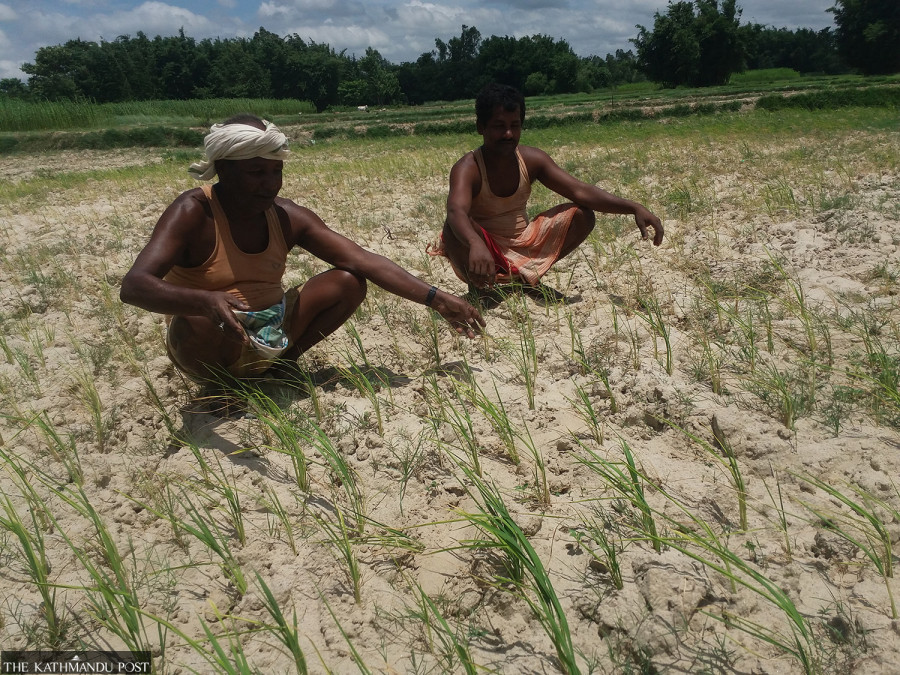Columns
Droughts top the climate hazard list
People have been displaced by water-induced disasters since the early 1960s.
Madhukar Upadhya
Weather forecasts over the past several months have been failing—last winter was dry, and the expected rain in April/May, which would mark the beginning of the farming calendar, has been largely nominal. A few drizzles helped douse the wildfires that had engulfed large swaths in several districts but not nearly enough to build up soil moisture for summer crops. However, the drought made headlines for a different reason—especially when the wildfires worsened the already polluted air, making Kathmandu the most polluted city globally.
Extreme weather events, including droughts, largely driven by global phenomena, have been wearying our opportunities and attempts to prosper. Key sectors like agriculture and hydropower, which Nepal banks on for economic growth, are severely impacted. Yet, the issue is not getting the attention it deserves at home.
Extensive drought
While our climate concerns remained focused on rising temperatures and the loss of snow deposits, Nepal’s National Climate Change Survey Report, published last Monday, unsurprisingly revealed that widespread droughts are the foremost climate stressors affecting Nepal, hitting its agriculture the hardest. A staggering 65 percent of households and their farms have been continually affected by droughts for the last 25 years. No wonder our farming is shrinking like never before. The report cited the dramatic increase in diseases and insects affecting crops as well. About 50 percent of the households surveyed reported the emergence of new diseases in crops, and an even greater percentage reported the presence of new insects/pests affecting food production.
Consequently, fewer people are interested in farming; those who want to continue are being discouraged by these increased threats with no support whatsoever from the state. Alarmingly, the state fails to realise that if it doesn't extend meaningful and sustained support to tackle droughts, mainly in the hills, more people will be forced to quit farming—the direct repercussions of which will be a failure to meet the poverty and hunger goals of Agenda 2030. A drought-induced water shortage will also affect other goals such as health, gender, clean water and sanitation.
The survey’s shocking figures regarding water sources, especially for the hilly regions, are extremely worrying, to say the least. Nearly all households in the hills and the mountains in Karnali Province experienced a decrease in water in the streams. Likewise, over two-thirds of households in Sudurpaschim and Karnali hills reported streams completely drying up. About 80 percent of respondents in the Koshi hills reported springs and kuwas drying up. The figure is around 75 percent for Karnali and Sudurpaschim hills. Half of all households in Sudurpaschim-Tarai and around 30 percent in Madhesh-Terai reported hand pumps completely parched.
The survey found that almost half of all households have started using higher amounts of chemical fertilisers and improved seeds as adaptation measures. Water conservation, which would have helped address droughts, is practised by a mere 12 percent of the households, with only 2 percent relying on ponds to store rainwater—the sustainable and effective way to combat droughts.
Drying local water sources do not simply affect a few people who depend on them to meet domestic and agricultural water needs; they are a visible sign of the changes that have been taking place over decades—something the water managers failed to notice. In fact, anecdotes tell us that people have been displaced by one or another water-induced disaster since the early 1960s. The only difference is that the number of people leaving their villages then was small, and most could find better opportunities in urban centres within the country. Now, thousands of youths wanting to leave their villages due to the same disasters that pushed others to migrate over half a century ago are searching for better opportunities that are no longer available in the country.
The other extreme
Despite droughts, the overall amount of annual rainfall hasn’t changed much, which points to the very interesting but disturbing rise of the other extreme—high-intensity rain causing damaging floods. The report indicates a changing flood scenario, especially in the hills and the mountains. Nearly 65 percent of the mountain households experienced floods capable of harming physical infrastructure in the last five years, while around half of all households experienced landslides of the same calibre. The hilly region is no exception—nearly 50 percent of the households in the hills were affected by damaging floods and almost 41 percent by landslides. We are starting to see the consequences too.
In 2021, the floods in Melamchi, which drastically changed the river morphology, crippled the Melamchi Water Project, built over two decades to bring water to Kathmandu with a price tag of over Rs35 billion.
Two years later, heavy rains and floods damaged the physical structures of 31 hydropower projects in eastern Nepal, with an estimated loss of over Rs8 billion. This is a firm reminder that as the drought conditions intensify, so do the risks of severe floods, which will have repercussions on the government’s plan to produce 30,000 MW by 2035 to meet both domestic and export needs.
The nature of rainfall-induced floods in the mountain rivers, where large projects—especially hydropower plants—are built, are poorly understood and have become extremely unpredictable due to the shift in rainfall distribution. Short-duration high-intensity hill rains leave little time for advance warning or safety preparations.
Troubling times ahead
The promising economic sectors have all been affected by a degradation of the foundation they depend upon—the state of the natural environment, which is undergoing changes at the core, largely connected by changing seasonal hydrology. Though the authorities and communities can collectively breathe a great sigh of relief as light rain in early May doused the wildfires and reduced the chances of their spread this year, we need to be reminded that the year 2023 was the hottest year on record; there’s no reason why 2024 and beyond won’t continue to break the record, especially with no letup in emissions.
The resulting winter droughts in the years ahead are likely to be longer and more intense, along with the increased frequency of devastating floods. Droughts will continue to impact food production. Forest fires will continue to cover large areas as the factors that trigger them continue to build up and spread. However, we can and need to encourage as many households as possible to save monsoon rainwater in dugout ponds to help revive the lost or declining water sources. We cannot remain complacent and oblivious to how deep-rooted the problem has gotten.




 8.12°C Kathmandu
8.12°C Kathmandu















